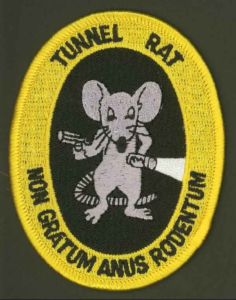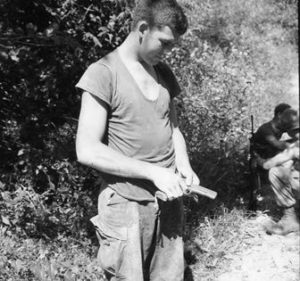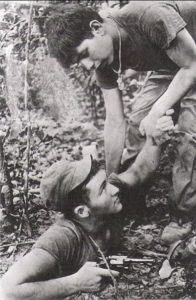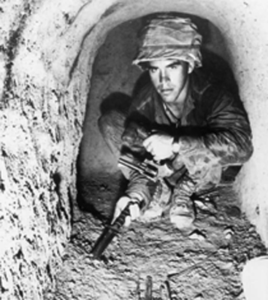Tunnel Rats – Unsung Heroes in the Vietnam War
This is for those who have asked the question – What’s a tunnel rat?

A four-legged rodent running through tunnels, subways, or sewers, right? Technically, yes. But ask a Vietnam veteran, and you’ll get a very different answer. Tunnel rats were a rare breed of soldier, small in stature because they had to be, but long on guts, because they needed to crawl through small dark tunnels with a flashlight, a pistol, and a knife. They moved silently and slowly through miles of sinuous interconnecting tunnels never knowing what lay beyond the next turn. There were booby traps, VC, and other denizens of the dark – scorpions, snakes, spiders, bats, and fire ants. It took a special breed of soldier to volunteer to be a tunnel rat.
You can read about their exploits in books, blogs, and Internet forums, but one thing is for sure – only a tunnel rat remembers the fear and adrenaline rush it took to enter those tunnels. Here is a glimpse into that dark, claustrophobic, and dangerous battleground fought beneath the surface of Vietnam.
The Tunnels of Vietnam – Key to Vietnamese resistance
The tunnels were critical to the North Vietnamese guerrilla warfare effort against the superior forces of the United States and its allies. Two tunnels systems are referenced here – the Vinh Moc tunnels located in South Vietnam (about 100 kilometers north of Hue and 550 kilometers south of Hanoi), and the more extensive Cu Chi tunnels just northwest of Saigon. Today, remnants of these complexes are tourist attractions – much different now than during the Vietnam War.

The Vinh Moc tunnels were excavated over a 13-month period in 1965-66 where over 300 people lived underground away from the ravages of war.

The Cu Chi tunnels began development during World War II and the French-Indochina conflict in the 1940’s and 1950’s. When the United States entered Vietnam in support of the South Vietnamese government, the North Vietnamese saw U.S. intervention as another impediment to their ongoing effort to unite North and South Vietnam under a communist government.
With the influx of American and Australian troops, the VC expanded the Cu Chi complex to over 200 kilometers of sinuous interconnecting tunnels. They provided cover and hiding places for enemy combatants and in some cases whole villages. They served as bases of operation for major offensives, intelligence, communication, storage facilities, hospitals, and dormitories. The North Vietnamese used them to set up sniper positions, booby-traps, and attacks behind enemy lines.
In 1966, during Operation Crimp, the US and Australian forces mobilized to rid the Cu Chi area of VC resistance. Instead of finding enemy strongholds, the VC had disappeared into the landscape – into the tunnels. After Operation Crimp, some recognized the importance of the tunnel complexes to the North Vietnamese war effort. A report stated:
“A trained tunnel team is essential to the expeditious and thorough exploitation and denial of the Viet Cong tunnels. Tunnel teams should be in a ready status to provide immediate expert assistance when the tunnels are discovered. Tunnel team members should be volunteers. Claustrophobia and panic could well cause the failure of the team’s mission or the death of its members.”
Tunnels were designed with twists and turns to protect tunnel inhabitants from direct gunfire, smoke from smoke grenades, and shrapnel from explosives. Tunnels zigzagged between 60 degrees and 120 degrees and usually ranged in width between 1.2 meters (4 feet) and 0.8 meters (2.5 feet). Trapdoors, placed to hide entrances to tunnels were often booby-trapped.
Initial attempts to locate, explore, and destroy the tunnels required the first tunnel rats to fight a war for which none had trained – they faced tunnel cave-ins, booby traps, and one-to-one combat with the enemy in the dark and narrow passages. They fought the denizens of the dark including snakes, scorpions, and rats (real ones) either left by the VC or inhabiting the tunnels naturally. Some suffocated in oxygen depleted tunnels following smoke grenade attacks. The lessons learned in this on-the-job (OJT) training helped future tunnel rats survive the hostile environment.
The Tunnel Rat – Fighting a different kind of war
All tunnel rats were volunteers. Why? From The Tunnels of Cu Chi:
“Tunnel rats were obliged to perform the most unnatural and stressful tasks to crawl through pitch-dark narrow, low earthen tunnels for hundreds of yards, facing the threat of sudden death at any moment.”

The narrow tunnels required a special type of soldier, small but courageous enough to go where other soldiers would not. These early “tunnel runners” or “ferrets” as the Australians called them were usually no more than 5′ 6″ tall and weighed under 130 lbs.

They entered a tunnel opening with no more than a light, a pistol, and a knife or bayonet. They fought the darkness and claustrophobia as well as the VC. Guys with nicknames like “Shorty” became special because of their size, or lack of it – they had the physical ability to crawl through the narrow tunnels designed for the smaller Vietnamese, and they had the courage to do it. Not just anyone could be a tunnel rat.
A Day in the Life
A tunnel rat entered a tunnel with as little as he needed to survive. The narrow twisting tunnels made it impossible to take much gear, especially his rifle. Many chose a revolver, instead of the regulation .45 caliber sidearm. Shooting in the tunnels caused temporary deafness, and the revolver, though loud and deafening, wasn’t as bad as the .45. He used the knife to check for booby-traps and the pistol to fire around corners if he thought North Vietnamese fighters lay in wait.
In the darkness of the tunnels, the tunnel rats developed a keen sense of smell and hearing. Some said they could smell the enemy soldiers ahead while others could hear them breathing. They had to determine their situation before the firing began after which their hearing and sense of smell were obliterated by noise and cordite.
In the Tunnel Tales From Vietnam (with excerpts from Jonathan Jones’ memoir – Beneath the Bamboo – A Vietnam War Story), Jones, known as Short Round, entered a tunnel carefully, and quietly moved forward until he’d come to what he thought was the tunnel’s end. He heard voices, seemingly far away – the tunnel extended on. He found an extremely sharp turn and made his way forward. He crept up on a VC, and as he prepared to fire, the VC grabbed for his wrist. Short Round fired twice, killing the VC instantly. There was a problem:
“Immediately, he was aware of one major drawback of this tunnel hunting operation. He couldn’t hear anything except his ears roaring from the explosion. He felt as if he had suddenly stuck his head underwater. All the sound had been snuffed out except for the tremendous roar in his ears.”
Some tunnel rats found the tunnels exciting and an adrenaline rush. They overcame claustrophobia, darkness, and the damp environment to ferret out and kill the enemy up close. After one tunnel rat was wounded in tunnel combat and sent to the hospital, he talked constantly about getting back to his unit. He couldn’t wait to get back into the tunnels.
Another tunnel rat was buried in a cave-in after raising a trap door and setting off a booby trap. It took his men over thirty minutes to extricate him. He was barely breathing when the dust-off flight picked him up. After recovering in the hospital, he was reported AWOL after medical personnel discovered him missing. He wasn’t AWOL at all – he’d returned to his unit to get back in the tunnels.

After facing danger in the tunnels, tunnel rats found that exiting a tunnel was risky, too. They’d find themselves on the business end of M-16s and friendly fire if they popped up in the middle of a clearing. Usually shirtless and covered in mud, their comrades found it difficult to distinguish them from the enemy.
Not all tunnel rats relished the dark, hot, and claustrophobic atmosphere of tunnel warfare, and stress took its toll. One tunnel rat, eking his way through a narrow tunnel, came face to face with big rat (rodent) standing on its hind legs baring its teeth looking like a creature from a horror movie. That was it. He backed out of the tunnel as quickly as he could and never entered another tunnel. It was as though the horrors he’d faced eventually caught up with him, and it was time to leave the tunnels to others.
Harold Roper, tunnel rat for the 25th Infantry summed up his experience:
“I never felt more fear than I’ve come close to before or since…”
“The Viet Cong would take their dead after a battle and put them down in the tunnels…”
“Finding them wasn’t pleasant, but we’d killed them, so it didn’t matter. It was worse if they’d been down there for a week.”
“I came across rotting bodies several times. It didn’t revolt me.”
“I was trained to kill and I killed. Looking back, it’s unreal. Unnatural. It’s almost like someone else did it. It wasn’t really me, because I wouldn’t even think of doing anything close to that again.”
Tunnel Rat Squad
By 1969, the 1st Infantry established the Tunnel Rat Squad with Lt. Jack Flowers as the leader (Rat Six). In one tunnel mission as point man, he opened a trap door, ready to fire, when a grenade rolled down into his lap. He and his fellow tunnel rat beat a hasty retreat but were wounded and rendered deaf by the exploding grenade. Their comrades extracted them, and a helicopter evacuated them to a hospital.
Time in the tunnels took its toll on Lt. Flowers. Later, as he and his men chased VC through the landscape and discovered a tunnel they were sure was their escape route. Lt. Flowers was next in rotation to enter the tunnel, knowing he’d face VC at the bottom. During his descent on a cradle of straps, he said fear gripped him:
“…the fear that knows no ranks and possesses every young man who faces the reality that his life might be stolen from him in a few, fleeting seconds.”
He dropped the final three feet and started firing at the face of a VC he saw standing in front of him while trying to protect himself from the gunfire he knew was coming. After firing all six shots in his revolver, he saw there was no one there. He’d imagined it. He was unceremoniously relieved of duty and sent stateside. No acknowledgment of the incredible and brave work he’d accomplished. No hero’s welcome. No send-off. Just a return stateside with all the nightmares that followed.
As the Tunnel Rat Squads evolved, they became well-oiled machines operating in groups of 5-6 men working in highly coordinated teams. They were recruited specifically for tunnel warfare exhibiting survival skills and a psychological proclivity to crawl and work in stressful situations. They followed specific protocols thus reducing the number of casualties. No man entered a tunnel alone and two tunnel rats waited at the entrance to aid should anyone in the tunnel need assistance. They communicated with each other constantly using methods they developed to reduce noise and their exposure to enemies in the tunnels.
The tunnel rat mystique grew as the war continued. Their contributions to the war effort were acknowledged and revered by their fellow warriors. Tunnel rats earned the same kind respect and admiration as other warriors who faced danger daily such as the helicopter pilots and long-range reconnaissance teams. Some came through the war relatively unscathed physically or emotionally. Others faced the nightmares that only those crawling through dark, narrow, dangerous tunnels can know.
After the Vietnam War
Tunnel rats are hard to find these days. They don’t represent a large percentage of the warriors who served in Vietnam, and they tend to be loners and not as likely to join veteran’s groups. Like many Vietnam veterans, they found it difficult to talk about the things they were forced to do to survive in the tunnels of Vietnam, but some have begun to speak of their experiences. Without the accounts of these brave men who entered and cleared the tunnels in Vietnam, this aspect the Vietnam War would be lost forever. Thank you, tunnel rats, and welcome home!

